第二课时Unit4SectionA3a
- 格式:doc
- 大小:44.00 KB
- 文档页数:2

人教版英语九年级全一册教案:Unit4 SectionA(3a-3c)Unit4 SectionA(3a-3c)教案【教材版本与册数】新目标人教版九年级上册【单元名称】Unit4 I used to be afraid of the dark.【课时】Section A 3a-3c(第2课时)【课型】Reading(阅读课)第 2 页第 3 页教材分析第 4 页教学目标教学重难点教学重点:1.正确使用Section A 3a-3c所有重点单词,短语和句型;正确使用used to结构,包括肯定、否定、疑问及其回答。
2.学习用描述人的个性的词汇描述人的变化。
教学难点:学用描述人的个性的词汇描述人的变化。
建议教法以任务型教学作为课堂教学理念、利用引导法和三步阅读教学法完成相应阅读任务。
Pre-reading: lead in-PresentationWhile-reading: Skimming- Scanning– Intensive reading-Listening and readingPost-reading: Retelling-Discussion-Inference-Different activities第 5 页教学流程(详见相应教学设计)教学评价1.本课时的目标设计清晰可操作,活动的设计紧扣目标要求并与目标达成一致。
2.读中的活动设计遵循语言规律,符合阅读课目标,由浅入深,环环相扣,能兼顾边缘生。
3.读后的活动设计体现运用教材有创造性,补充内容有针对性,拓展知识有可行性,课后作业能体现知识的迁移性。
有利于对学生思维品格的训练与培养。
【本课时教学设计】步骤过程措施(教师活动与学生活动)目的持续性评价DELC4 1预备与激活先期知识Step 1Greeting andLeading in( 3mins)Greet the class as usual and ask Ss to reviewusing “used to” and “ now”. E.g.T:What did you use to be like?S: I used to be shy.T:Are you still now?S: No, I’m not.I am popuar..2.T asks Ss some students.(1) How have you changed since you was a child?(2) What does it help you with?利用IQEE策略,利用复习所学描述人物外貌和性格的方法及词汇,通过老师询问学生从小到大的转变的问题与本堂课的话题Candy的人生经历变化建立起记忆连接。
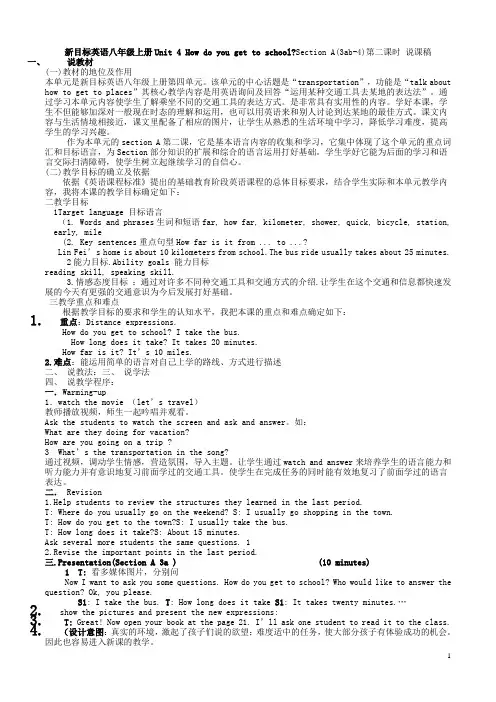
新目标英语八年级上册Unit 4 How do you get to school?Section A(3ab-4)第二课时说课稿一、说教材(一)教材的地位及作用本单元是新目标英语八年级上册第四单元。
该单元的中心话题是“transportation”,功能是“talk about how to get to places”其核心教学内容是用英语询问及回答“运用某种交通工具去某地的表达法”。
通过学习本单元内容使学生了解乘坐不同的交通工具的表达方式。
是非常具有实用性的内容。
学好本课,学生不但能够加深对一般现在时态的理解和运用,也可以用英语来和别人讨论到达某地的最佳方式。
课文内容与生活情境相接近,课文里配备了相应的图片,让学生从熟悉的生活环境中学习,降低学习难度,提高学生的学习兴趣。
作为本单元的section A第二课,它是基本语言内容的收集和学习,它集中体现了这个单元的重点词汇和目标语言,为Section部分知识的扩展和综合的语言运用打好基础。
学生学好它能为后面的学习和语言交际扫清障碍,使学生树立起继续学习的自信心。
(二)教学目标的确立及依据依据《英语课程标准》提出的基础教育阶段英语课程的总体目标要求,结合学生实际和本单元教学内容,我将本课的教学目标确定如下:二教学目标1Target language 目标语言(1. Words and phrases生词和短语far, how far, kilometer, shower, quick, bicycle, station, early, mile(2. Key sentences重点句型How far is it from ... to ...?Lin Fei’s home is about 10 kilometers from school.The bus ride usually takes about 25 minutes.2能力目标.Ability goals 能力目标reading skill, speaking skill.3.情感态度目标:通过对许多不同种交通工具和交通方式的介绍.让学生在这个交通和信息都快速发展的今天有更强的交通意识为今后发展打好基础。
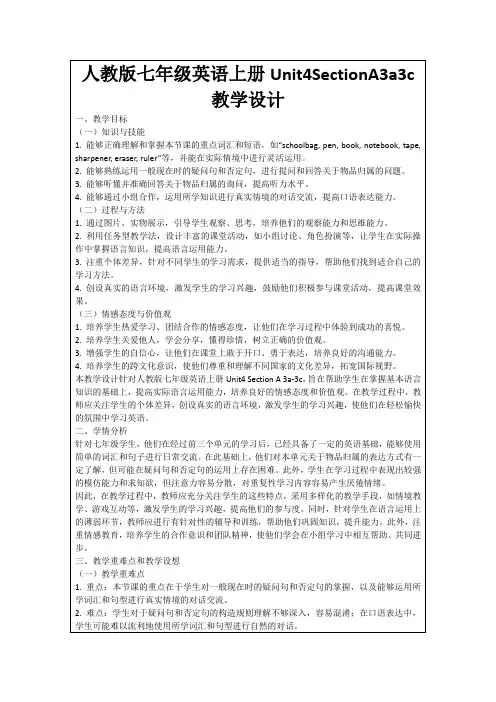
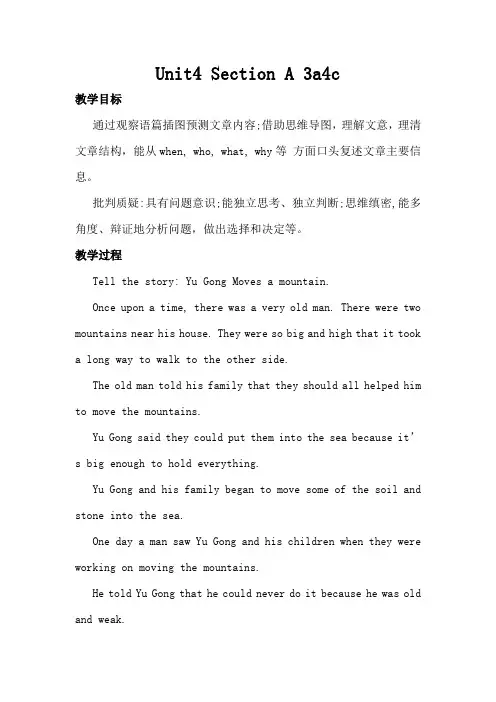
Unit4 Section A 3a4c教学目标通过观察语篇插图预测文章内容;借助思维导图,理解文意,理清文章结构,能从when, who, what, why等方面口头复述文章主要信息。
批判质疑:具有问题意识;能独立思考、独立判断;思维缜密,能多角度、辩证地分析问题,做出选择和决定等。
教学过程Tell the story: Yu Gong Moves a mountain.Once upon a time, there was a very old man. There were two mountains near his house. They were so big and high that it took a long way to walk to the other side.The old man told his family that they should all helped him to move the mountains.Yu Gong said they could put them into the sea because it’s big enough to hold everything.Yu Gong and his family began to move some of the soil and stone into the sea.One day a man saw Yu Gong and his children when they were working on moving the mountains.He told Yu Gong that he could never do it because he was old and weak.As soon as the man finished talking, Yu Gong said that his family could continue to move the mountains after he died.His family would live and grow, but the mountains could not get bigger. So Yu Gong and his family kept on digging day after day and year after year.Finally, a god was so moved by Yu Gong that he sent two gods to take the mountains away.格林兄弟雅各布·格林和威廉·格林,他们是德国19世纪著名的童话搜集家。

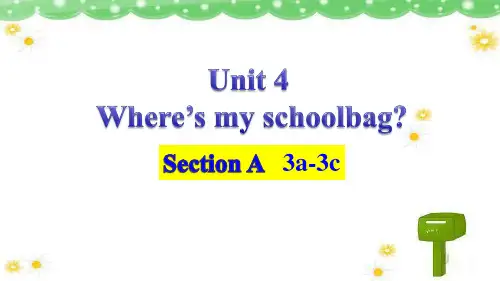
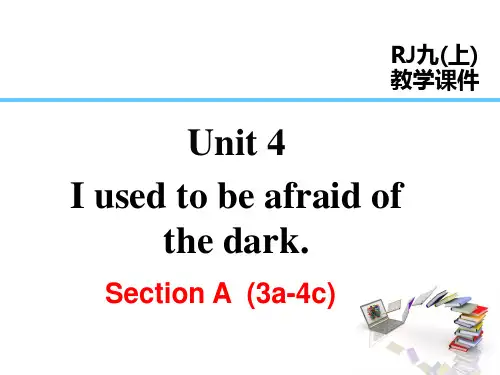
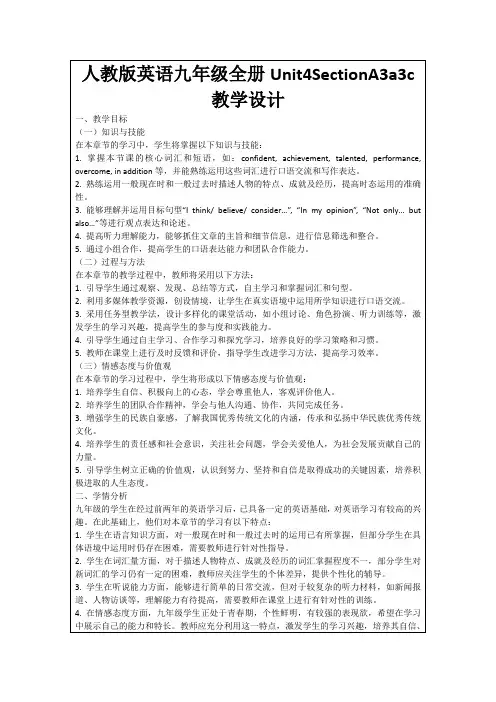
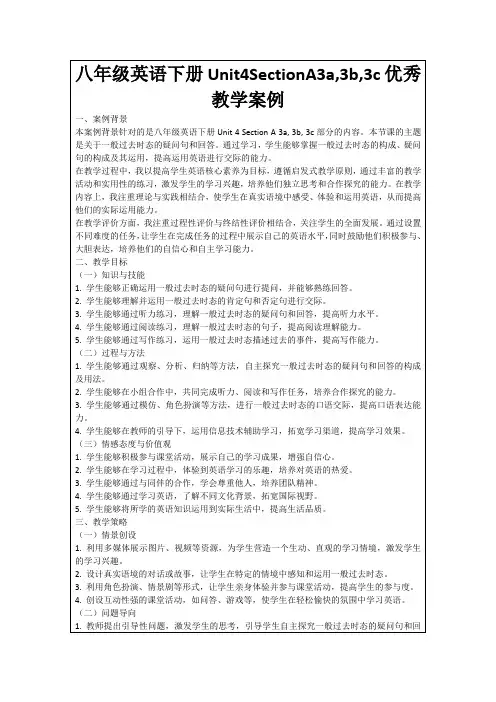
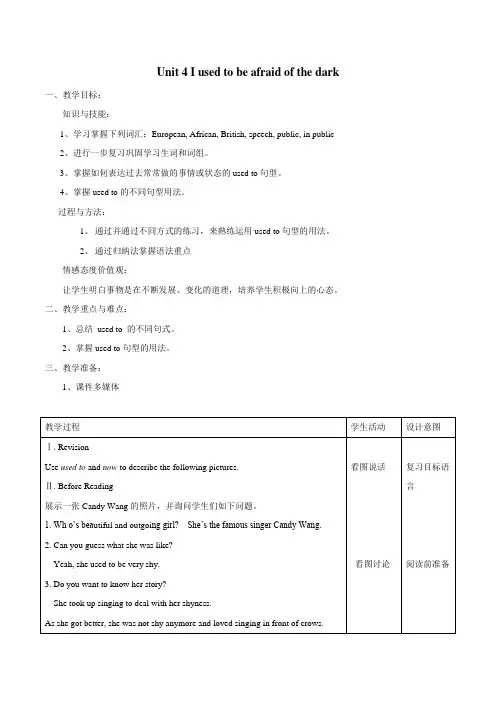
Unit 4 I used to be afraid of the dark 一、教学目标:
知识与技能:
1、学习掌握下列词汇:European, African, British, speech, public, in public
2、进行一步复习巩固学习生词和词组。
3、掌握如何表达过去常常做的事情或状态的used to句型。
4、掌握used to的不同句型用法。
过程与方法:
1、通过并通过不同方式的练习,来熟练运用used to句型的用法。
2、通过归纳法掌握语法重点
情感态度价值观:
让学生明白事物是在不断发展、变化的道理,培养学生积极向上的心态。
二、教学重点与难点:
1、总结used to 的不同句式。
2、掌握used to句型的用法。
三、教学准备:
1、课件多媒体
板书设计
Unit 4 I used to be afraid of the dark.
第二课时Section A (3a-4c)
1. 否定句
used not
主语+ to do sth.
didn’t use
2. 一般疑问句
Did + 主语+ use + to do…?
答语:Yes, sb did. / No, sb didn’t.
3. 反意疑问句
主句,didn’t + 人称代词?。
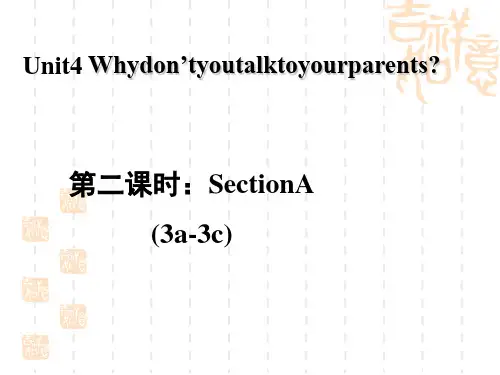
Section A 第二课时教学设计教学内容Section A: 3a. 3b. 4教学目标知识与能力1.Match the vocabulary: bank clerk. police officer. waiter. reporter. nurse. hospital. restaurant. TV station. Police Station.2.Master and use: Where does your sister work? She works in hospital.What does she do? She's a doctor.过程与方法练习询问职业以及在哪儿工作,注意使用第三人称单数,大面积练习,让更多的学生有练习的机会,采用学生提出问题,学生解决问题,借助课件让学生如身临其境。
情感态度价值观职业不分贵贱,懂得社会分工不同。
教学重、难点及教学突破重点1.The vocabulary2.Language: Where does your sister work? She works at a hospital.What does she do? She's a doctor.难点Use the language to ask for the jobs and the places where people work.教学突破通过角色扮演,熟悉句型和生词。
教学准备教师准备录音机、磁带、课件学生准备预习生词和课文教学步骤本课小结本节课学习了20个单词如:nurse, a lot of, money, mine, count, patient, angel, dangerous, thief, afraid,be afraid of, station, TV station, police station, pop star, late, out, go out. Where does he work? He woks in ahospital. 通过学习学生已经掌握了职业和工作地点的句子。
第二课时Unit 4 Section A3a-4【Learning objectives】Knowing : 本课的9个单词Habit----forming: How do you get to school? / How long does it take?How far is it from his home to school? . Practising: 熟练运用本课句型谈论交通方式、时间及距离。
【Important points】继续学习谈论交通的句型,描述路线。
【Learning process】(教师寄语: Practice makes perfect)一、自主学习(教师寄语: No pains, no gains)Task 1. 学习3b。
1、个人自读下列对话,理解并背诵对话。
A:How do you get to school? B:I take the subway.A:How far is it from your home to school? B:It's three miles.A:How long does it take you to get from home to school? B:It takes 25 minutes.2、讲解:How far is it from your home to school?是一个用来询问两地间距离在常用句型,“how far”意为“多远”,回答时要用表示距离的短语。
例如:---北京距离上海多远?---大约1462 千米。
写出下列短语的汉语意思并展示。
get to________ how long________ how far________from to________ get up________ leave for________has a quick breakfast_________ the bus station_____ride one'bicycle to________ take sb.to_______take the subway_______ look at_______写出下列英语句子他是如何到校的?他每天步行到校。
他每天步行到校要花多少时间?要花大约20分钟。
从他家到学校大约有多远?大约有3公里。
Task 2. 学习3a1、自读3a短文,理解短文意思。
2、听录音,纠正发音。
3、完成下列短语:迅速的吃过早饭前往,“到……去”乘公共汽车带去,送去大约六点半4、讲解:①“quick”为形容词,意为“快速地”,“have a quick breakfast”也可以说为“have breakfast quickly”②“leave for ”意为“前往……,到…去”,不强调离开哪里,只强调要去的地方。
例:下星期我们将动身去西藏。
③“take”为“带去,送去”,与to 搭配,take……to意为把某人某物带到某地去。
例:早晨妈妈送我去学校。
二、合作共建1、询问你的好朋友从学校回家的方式、所需时间、距离。
三、系统总结(教师寄语:Tomorrow comes never.)1、总结本课学习的询问距离的句型及回答:2、如何描述路线?常用哪些句子?四、诊断评价(教师寄语: Look before you leap)一、选择:1、It takes him 20 minutes to school.A、to walkB、walkingC、walksD、walk2、---When do you usually get up,Mary?--- 6:30 in the morning.A、InB、OnC、WithD、At3、It's about ten walk from here.A、minutes'B、minute'sC、minutes'D、minute of4、My sister always takes the train home.A、inB、onC、toD、at二、句型转换1、It takes me two hours to go there.(对划线部分提问)2、It is about 10 kilometres away from here.(对划线部分提问)3、My mother usually takes the bus to work.(改为否定句)五、1、用所给词的正确形式填空。
1) It (take) me half an hour to do my homework every day .2) He (walk) to school every day .3) I'm new here. I need (buy) a map of the city .4) How long does it take you (do) your homework ?5) 60 (minute) is an hour.2 、翻译句子1)你怎样到达学校?骑自行车。
2)要花多长时间?大约40分钟。
3我通常步行,但有时乘公共汽车。
.4 )步行花25分钟,坐车花10分钟。
.5 )做作业每天花费你多长时间??6 )我姐姐用15分钟吃早饭。
III. 用所给单词的适当形式填空:1. It’s about twenty ___________ (minute) walk to get there.2. A small number of students ________ (take) the subway every day.3. My bag is ___________ (difference ) from hers.4. How long does it take you ________ (get) to the park?5. Traveling by train is more relaxing than ____. (drive)IV. 选择填空:( ) 1. They arrive ____ Shanghai ____ a warm afternoon.A. in, inB. at, inC. in, onD. at, at( ) 2. That’s going to ____. A. fun B. more fun C. be more fun D. be funs( ) 3. I ____ half an hour ____ English every morning.A. take, to readB. take, readingC. spend, to readD. spend, reading ( ) 4. The number of the books in this library ____ almost 2,000,000.A. isB. amC. areD. /( ) 5. —____ does it take him to do the housework? —For two hours.A. How soonB. How longC. How manyD. How often( ) 6. ____ he / He is old, ____ he is in good health.A. Although, butB. /, thenC. Although, soD. /, but( ) 7. —____ do you live from the park? —About twenty miles.A. How soonB. How muchC. How farD. How long( ) 8. —How do you usually go to school? —I usually go to school ____.A.by a bikeB.on bikeC. ride a bike D、by bike. .1. She rides her bike to school. (对划线部分提问)______ _______ she ____ ____ school?2. Most students in North America go to school on the bus. (改为同义句)Most students in North America go to school ____ _____.3. the, early, takes, bus, him, his, to, workplace (连词成句)____________________________________________4. How do you like China? (改为同义句) ______ do you ________ ___ China?5. I go to the cinema once a week. (对划线部分提问) _____ _______ do you go to the cinema?6. They often go to the park on foot. (改为同义句) They often ______ ___ the park.7. My mother goes to work by train. (改为同义句) My mother ________ _____ _______ to work.8. They have breakfast at eight fifteen. (改为同义句)They have breakfast at ____ ________ ______ ________.9. It takes them about two hours to get to the bus station. (对划线部分提问)______ _______ does it take them to get to the bus station?10. Mr Brown leaves home on a bike. (对划线部分提问) _____ ______ Mr Brown ________ home?VI. 从方框中选择最佳答语补全对话:(有两项是多余的)A. By bike or by bus.B. Only a few.C. I’m fine, thank you.D. What do you like about it?E. Do you think so?F. Some students live near school, they usually walk.G. By bike. But something is wrong with my bike today.( A-Jim, B-Ann )A: Hello, Ann. How are you?B: (1)A: How do you usually come to school?B: (2)A: I’m sorry to hear that. How do most students in your class come to school?B: (3)A: What about the other students?B: (4)A: Does anybody come to school in a car?B: (5)五:teaching notes:。